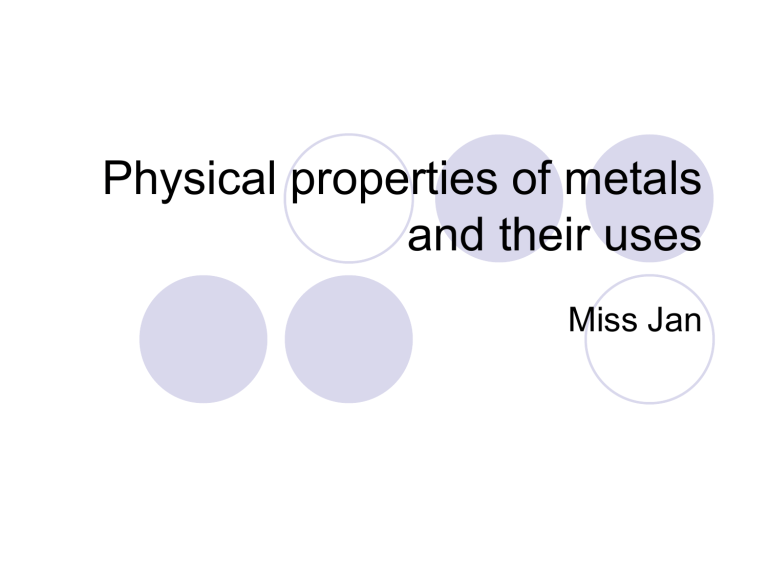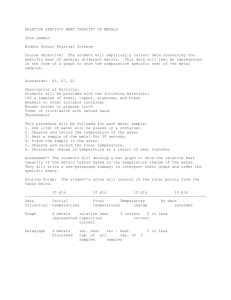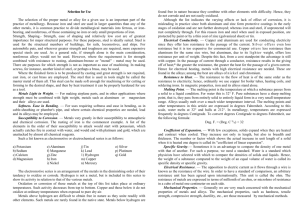Physical properties of metals and their uses

Physical properties of metals and their uses
Miss Jan
Physical properties of metals SLOs
understand how the uses of metals are based on their properties
Know these terms: electrical conductivity, thermal conductivity, density, ductility, lustre, and malleability
understand how the crystal structure of metals can explain their physical properties
be able to name some common alloys
understand why alloys are useful
Metal
Physical Properties of some metals
(Worksheet)
Symbol Atomic mass
Melting point (
C)
State at
25
C
Density
(g cm
–3
)
Magnesium Mg 24 650 1.7
Aluminium
Iron
Copper
Al
Fe
Cu
27
56
64
660
1535
1083
Solid
Solid
Solid
Solid
2.7
7.8
8.9
Zinc
Silver
Gold
Mercury
Lead
Zn
Ag
Au
Hg
Pb
65
108
197
201
207
1500
961
1063
–39
327
Solid
Solid
Solid
Liquid
Solid
7.1
10.5
19.3
13.6
11.3
3. Why is Mercury an unusual metal?
It is the only metal that is liquid at room temp
4. List the metals in the table in order of increasing melting points.
Hg, Pb, Mg, Al, Ag, Au, Cu, Zn, Fe
5. Which metal has the lowest melting point? Which has the highest melting point?
Lowest: Hg, Highest: Fe
6. List the metals in order of increasing density.
Mg, Al, Zn, Fe, Cu, Ag, Pb, Hg, Au
7. Which metal has the highest density?
Which has the lowest density?
Highest: Au, Lowest: Mg
8. Is there a general relationship between density and atomic mass?
Generally, as the atomic mass increases, the density increases
Use NMS 2 page 52 to complete the table on the worksheet
Metals are
Sonorous
Lustrous
Malleable
Ductile
Solids with high melting points
Good conductors of heat
Good conductors of electricity
This means they This is used in Which are made of
Make a ringing sound when hit
Cymbals in an orchestra
Brass, steel
Brainpop
http://www.brainpop.com/science/matteran dchemistry/metals/
Metals are This means they
This is used in
Which are made of
Sonorous Make a ringing sound when hit
Cymbals in an orchestra
Brass, steel
Lustrous
Malleable
Ductile
Are shiny Mirror/
Jewellery
Silver,
Gold
Can be beaten into shape without shattering
Car bodies Steel
Can be stretched out to form a wire
Wires
Steel
Metals are
Solids with high melting points
This means they
Can withstand heat
Good conductors of heat
Transmit heat easily
This is used in
Which are made of
Heating elements
Pots and pans
Nickel alloys
Steel, aluminium,
Copper
Good conductors of electricity
Allows electricity to pass through
Electrical wires
Copper
Crystal structure of metals
Atoms packed tightly (lattice)
Strong forces between atoms makes metal strong and hard to melt.
Outer electrons (valence e ) free to move about this is how metals conduct heat and electricity
Moving electrons also reflect light lustre
Alloys
Mixture of metals
Have different properties to the original pure metal from which it was made from
E.g.
Amalgam: mercury with another metal
(metal fillings)
Brass (Cu + Zn) – easy to shape
Steel (Fe + C) and Bronze (Cu + Sn)
– stronger, resist corrosion
Alloys worksheet - True or false?
1.
True
2.
True
3.
False: steels are alloys of iron
4.
False: Bronze contain copper and tin
5.
True
6.
True
7.
False: Brass is a very hard alloy
8.
True
9.
False: magnets are made of iron, nickel and cobalt
Photograph of a man sitting on a pool of mercury
Mercury is so dense, and clings to itself so strongly, than the man floats on it like styrofoam floats on water.
NMS 2 Page 52-53
1.
Uses of metals
Metal
Aluminum
Gold
Copper
Use
Jewellery
Properties
Cooking foil 1. Easily rolled into thin sheets.
2. Doesn’t melt in the oven.
1. Attractive colour.
2. Doesn’t corrode.
Chromium Bathroom
Lead
Electrical wiring fittings
Pipes
1. Good conductor of electricity.
2. Easily drawn into wires.
1. Shiny.
2. Doesn’t corrode.
1. Soft.
2. Melts easily.
3. Doesn’t corrode.
2.
An alloy is a mixture of two or more metals.
3. Alloys are used because they have more useful combinations of properties than pure metals.
4.
See table, p. 53, and the worksheet on alloys.








